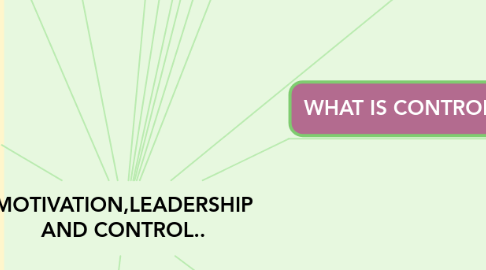
1. Motivation - Forces affecting people's behavior
2. SATISFIED EMPLOYEES ARE MORE PRODUCTIVE AND MORE COMMITTED
2.1. Job satisfaction
2.2. High morale
2.3. Low turnover
3. High Priorities For Today's workforce.
3.1. Family Orientation
3.2. Sense of community
3.3. Quality of life issues
3.4. Volunteerism
3.5. Autonomy
3.6. Flexibility & Nonconformity
4. MOTIVATION IN THE WORKPLACE
4.1. The models of employee motivation theories : 1) Classical Theory / scientific management 2)Behavior Theory 3) Contemporary motivational theories
5. MANAGERIAL STYLES AND LEADERSHIP
5.1. Autocratic Style
5.2. Democratic Style
5.3. Free rein style
6. THE PLANNING CONTROLLING LINK
6.1. PLANNING
6.1.1. Goals
6.1.2. objectives
6.1.3. strategies
6.1.4. plans
6.2. ORGANIZING
6.2.1. Structure
6.2.2. HR management
6.3. CONTROLLING
6.3.1. Standards
6.3.2. Measurements
6.3.3. Comparison
6.3.4. Actions
6.4. LEADING
6.4.1. Motivation
6.4.2. Leadership
6.4.3. Communication
6.4.4. Individual and group behavior
7. PSYCHOLOGICAL CONTRACT
7.1. Organization's Inducements
7.2. Human Relations
7.3. Employee's Contributions
8. THE IMPORTENCE OF SATISFACTION &MORALE IN WORKPLACE..
8.1. Job satisfaction
8.2. Morale
8.3. Turnover
9. STRATEGIES FOR ENHANCING JOB SATISFACTION AND MORALE ..
9.1. Reinforcement/behavior modification
9.2. Management by objectives
9.3. Participative management and empowerment
9.4. Job enrichment and job redesign
9.5. Modified work schedules
10. 21st Century Leadership/management
10.1. Motivation
10.1.1. Money no longer prime
10.1.2. Different desires at work
10.1.3. Varying lifestyle reflect varying
10.1.4. Goals of employee
10.2. Leadership
10.2.1. Flatter organizations
11. WHAT IS CONTROLLING
11.1. Controlling is the process of measuring perfomance and taking action to ensure desired result.
11.1.1. IMPORTANCE OF CONTROLLING
11.1.1.1. It facilitates co-ordination
11.1.1.1.1. Control system provide managers with information and feedback
11.1.1.2. It helps in planning
11.1.1.2.1. Controls let managers know whether their goals and plans are on target
11.1.1.3. Protecting the workplace
11.1.1.3.1. Controls enhance physical security and help minimize workplace disruptions.
12. PROCESS OF CONTROLLING
12.1. Step 1 : Establishing standars
12.1.1. Establish performance objectives abd standards
12.2. Step 2 :Measuring performance
12.2.1. Measure actual performance
12.3. Step 3 : Compare actual perfomance with objectives and standards
12.3.1. Compare actual performance with objectives and standards
12.4. Step 4 : Take neccessary action
12.4.1. Take neccessaryaction
12.5. Measuring : How and what we measure
12.5.1. Sources of information (How)
12.5.1.1. Personal observation
12.5.1.2. Statistical reports
12.5.1.3. Oral reports
12.5.1.4. Written reports
12.5.1.5. What control criteria ?
12.5.1.5.1. Employees
12.5.1.5.2. Financial
13. Three Types of Control
13.1. Work input
13.1.1. Work Throughputs
13.1.1.1. Work Outputs

